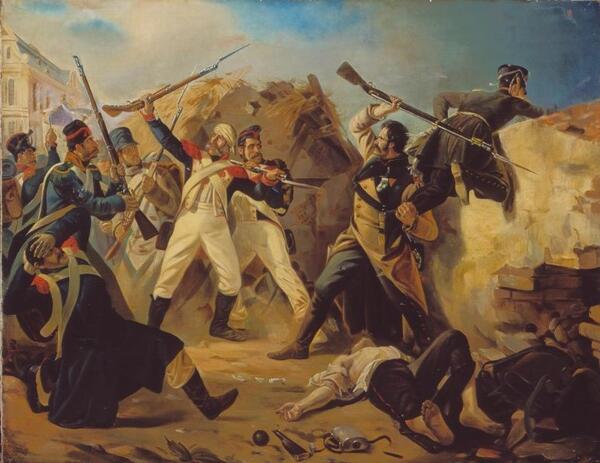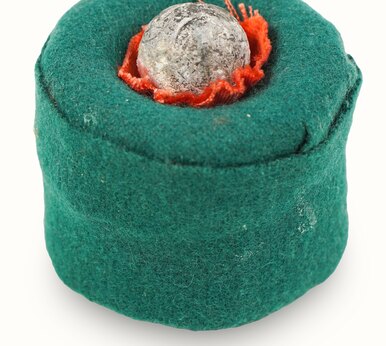The Battle of Leipzig, also known as the “Battle of the Nations”, put an end to the Napoleonic wars. The Allied armies forced Napoleon’s troops to retreat. The campaign of 1813 was over; in 1814, the Allies entered France, and Bonaparte abdicated the throne for the first time.
Among the heroes of the battle was Grenadier-Corporal Leontiy Leontievich Korennoy. By the beginning of the campaign in 1812, he was in the 3rd Grenadier company of the Finnish Life Guards Regiment, to which the best soldiers were transferred. For the Battle of Borodino, Korennoy was awarded the “soldier’s St. George Cross”. His fellow soldiers respectfully nicknamed the veteran mentor “uncle Korennoy”.
During the assault on the village of Gossa, the battalion commander, Colonel Alexander Karlovich Gervais, with several officers and ordinary jaegers, moved behind a stone fence in order to capture the enemy’s banner, but were surrounded by the French. Noticing that all the officers were wounded, Korennoy took command. After helping the commanders over the fence, he rallied the remaining jaegers around him: some rescued the wounded, others defended the occupied place. Having spent their ammunition, they began to attack with their bayonets. Korennoy was the last one who could defend himself, but he did not comply when the French called on him to surrender and continued to fight them with the buttstock of his rifle until he fell down under their onslaught. The courage of the soldier impressed the enemy. They took Korennoy to their dressing station and reported about him to Napoleon. The French emperor ordered to help the hero, and then let him go to his own troops. Moreover, in his order he stated that Korennoy was an example to all French soldiers. This story was eternalized by fellow soldiers of Korennoy in the song “We remember uncle Korennoy…”
When he returned to the regiment a few days later, Leontiy Korennoy was promoted to sub-ensign (the highest rank for a non-commissioned officer) and standard-bearer and awarded the medal “For the Love of the Fatherland”. This honorary silver medal was to be worn around the neck.
In the year of the centenary anniversary of the Finnish Regiment in 1906, a bronze monument to the hero created by the architect Ieronim Sevastyanovich Kitner, sculptor Egor Ivanovich Malyshev and caster Karl Angelovich Robekki was installed at the entrance of the building of officers’ assembly. In Soviet times, the monument was destroyed; the pedestal is still placed in the courtyard of the Suvorov Museum.
The presented canvas is a copy. The original painting (1846) was created by the battle artist Polydor Ivanovich Babayev. In 1913, the St. Petersburg publishing house of Ivan Dmitrievich Sytin printed the “Military Encyclopedia”, in the 13th volume of which this picture illustrates an article about Leontiy Korennoy.
Among the heroes of the battle was Grenadier-Corporal Leontiy Leontievich Korennoy. By the beginning of the campaign in 1812, he was in the 3rd Grenadier company of the Finnish Life Guards Regiment, to which the best soldiers were transferred. For the Battle of Borodino, Korennoy was awarded the “soldier’s St. George Cross”. His fellow soldiers respectfully nicknamed the veteran mentor “uncle Korennoy”.
During the assault on the village of Gossa, the battalion commander, Colonel Alexander Karlovich Gervais, with several officers and ordinary jaegers, moved behind a stone fence in order to capture the enemy’s banner, but were surrounded by the French. Noticing that all the officers were wounded, Korennoy took command. After helping the commanders over the fence, he rallied the remaining jaegers around him: some rescued the wounded, others defended the occupied place. Having spent their ammunition, they began to attack with their bayonets. Korennoy was the last one who could defend himself, but he did not comply when the French called on him to surrender and continued to fight them with the buttstock of his rifle until he fell down under their onslaught. The courage of the soldier impressed the enemy. They took Korennoy to their dressing station and reported about him to Napoleon. The French emperor ordered to help the hero, and then let him go to his own troops. Moreover, in his order he stated that Korennoy was an example to all French soldiers. This story was eternalized by fellow soldiers of Korennoy in the song “We remember uncle Korennoy…”
When he returned to the regiment a few days later, Leontiy Korennoy was promoted to sub-ensign (the highest rank for a non-commissioned officer) and standard-bearer and awarded the medal “For the Love of the Fatherland”. This honorary silver medal was to be worn around the neck.
In the year of the centenary anniversary of the Finnish Regiment in 1906, a bronze monument to the hero created by the architect Ieronim Sevastyanovich Kitner, sculptor Egor Ivanovich Malyshev and caster Karl Angelovich Robekki was installed at the entrance of the building of officers’ assembly. In Soviet times, the monument was destroyed; the pedestal is still placed in the courtyard of the Suvorov Museum.
The presented canvas is a copy. The original painting (1846) was created by the battle artist Polydor Ivanovich Babayev. In 1913, the St. Petersburg publishing house of Ivan Dmitrievich Sytin printed the “Military Encyclopedia”, in the 13th volume of which this picture illustrates an article about Leontiy Korennoy.



